#Henry's senior portrait:)
Explore tagged Tumblr posts
Text
Trying digital art again
Help

Henry but he looks nothing like the sketch I drew
#killer frequency#the whistling man#kfam#henry barrow#this was supposed to be part of the George Lives au#Henry's senior portrait:)
17 notes
·
View notes
Text
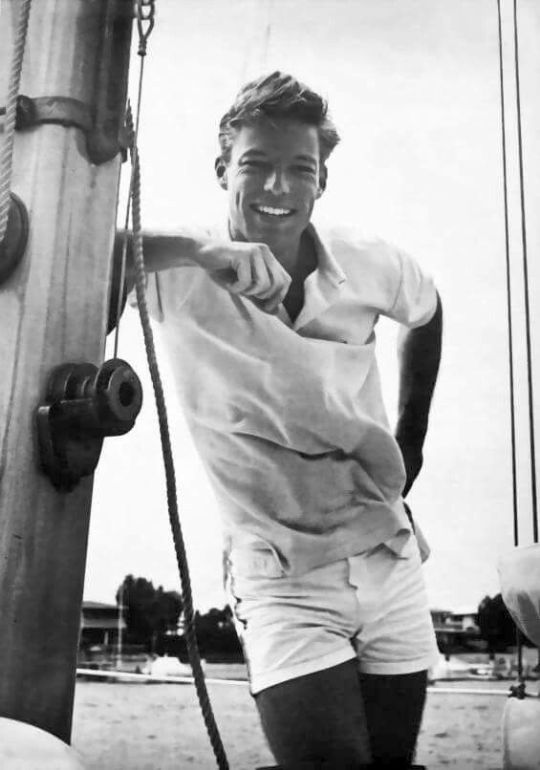
Richard Chamberlain
Dashing American actor best known for his many roles in hit TV series including Dr Kildare, The Thorn Birds and Shogun
Despite becoming a lauded stage and film actor, Richard Chamberlain, who has died aged 90, carried the label of soap-opera star around his neck for most of his career of more than five decades.
It began with his huge success in the hospital television series Dr Kildare (1961-66), in which Chamberlain’s clean-cut good looks were the prime attraction, bringing him thousands of fan letters a week. Chamberlain’s other immensely successful television roles came in three mini-series, Centennial (1978-79), Shogun (1980) and The Thorn Birds (1983).
His perfectly chiselled features, which made him ideal for romantic leads in soap operas, prevented many producers from visualising him in more demanding roles. However, through talent and determination he starred in numerous films and on the stage in parallel to his television work.

Born in Los Angeles, he had a cool relationship with his alcoholic father, Charles, a salesman, but a warm one with his mother, Elsa (nee Von Benzon). At Beverly Hills high school, he excelled in athletics, and his good grades enabled him to study art history and painting at Pomona College, southern California, where he was able to satisfy his dream of becoming an actor in plays by Shakespeare, Shaw and Arthur Miller. After graduating, Chamberlain served 16 months in Korea, where he was made company clerk of his infantry company, later promoted to the rank of sergeant.
On his return to the US, Chamberlain studied acting with Jeff Corey, who became renowned as a teacher after being blacklisted in Hollywood by the House Un-American Activities Committee.
Although Corey’s sense-memory Stanislavskian method is not immediately apparent in Chamberlain’s performances, the actor claimed to have learned how to tap into his own emotions and psyche. At the time, he was struggling with having to “live a lie” about his sexuality.
In 1959, Chamberlain, Leonard Nimoy and Vic Morrow were among the founders of the Company of Angels, a repertory theatre in Los Angeles. While playing there in La Ronde and The Caine Mutiny Court-Martial, Chamberlain started to get parts in television series. His first feature films were The Secret of the Purple Reef (1960), a low-voltage, low-budget thriller shot in Puerto Rico, and A Thunder of Drums (1961), a western in which he was hardly noticeable as a young cavalry officer.
Then came the role of Dr Kildare, for which Chamberlain beat 35 other candidates. In the first episode, the senior medic Dr Leonard Gillespie (Raymond Massey) tells Chamberlain, as the young, earnest, caring James Kildare, an intern at Blair general hospital: “Our job is to keep people alive, not to tell them how to live.” Kildare ignores the advice, thus supplying the basis for most of the plots of the next 190 episodes across five seasons.
In 1962, with his popularity at its height, he recorded a hit song, Three Stars Will Shine Tonight, based on the music of the show’s hummable opening theme. It revealed that Chamberlain had a fine singing voice, which he used on a number of singles and an album, Richard Chamberlain Sings (1962), and much later as leads in stage musicals such as My Fair Lady (1993), The Sound of Music (1998), Scrooge (2004), The King and I (2006) and Monty Python’s Spamalot (2009).
When Dr Kildare ended, Chamberlain decided to prove that he was not just a pretty face, by appearing in summer stock productions of The Philadelphia Story and Private Lives (both 1966).

He then worked for three years in Britain, on television, stage and film. He was excellent as Ralph Touchett in the BBC’s six-part adaptation of Henry James’s novel The Portrait of a Lady (1968).The role got him noticed by Peter Dews, the artistic director of Birmingham repertory theatre, who offered him the chance to play Hamlet in 1969.
The play was a sell-out for its limited five and a half week run, and in the main, the British critics were positive, with the Times reflecting the consensus: “Anyone who comes to this production prepared to scoff at the sight of a popular television actor, Richard Chamberlain, playing Hamlet, will be in for a deep disappointment.” The Daily Mail commented that “the perturbed spirit of Dr Kildare may rest at last. In Mr Chamberlain we have no mean actor.”
In films, he was a noble Octavius Caesar in Julius Caesar (1970), and a striking Lord Byron in Lady Caroline Lamb (1973), and he was able to express some of his own angst and sexual liberation as a gay Tchaikovsky in Ken Russell’s The Music Lovers (1971). At this time, it was an open showbiz secret that Chamberlain was romantically involved with the US actor Wesley Eure.
The rest of the films he made in the 1970s – The Three Musketeers (1973) and The Four Musketeers (1974), in which he played Aramis; The Slipper and the Rose (1976), almost typecast as Prince Charming; and the disaster movies The Towering Inferno (1974) and The Swarm (1978) – were lucrative but hardly challenging. He was more stretched in Peter Weir’s The Last Wave (1977), shot in Australia, where he was the initially smug lawyer defending a group of Indigenous Australians accused of murder.
In the meantime, Chamberlain had made a triumphant Broadway debut in Tennessee Williams’s The Night of the Iguana (1976-77) at Circle in the Square theatre. According to one critic, Chamberlain, as the defrocked priest now a tour guide, “captures the self-lacerating torment of Reverend Shannon”. During the run, he started a relationship with Martin Rabbett, a production assistant on the play. They remained together until 2010, and later resumed their partnership.
In the 80s, Chamberlain established himself again on television, earning the nickname “king of the miniseries”. Shogun, based on James Clavell’s novel, starred Chamberlain as Pilot-Major John Blackthorne, an Englishman trying to gain acceptance in early 17th-century Japan. Chamberlain, long-haired and black-bearded, held his own among a cast of superb Japanese actors that included the dynamic Toshiro Mifune.

In The Thorn Birds, he was sexy Father Ralph de Bricassart, the Roman Catholic priest who carries on a tortured, illicit romance with Meggie Cleary, played by Rachel Ward, in the Australian outback. It was disliked by Colleen McCullough, the author of the original 1977 bestseller. She said: “It was instant vomit! Ward couldn’t act her way out of a paper bag and Chamberlain wandered about all wet and wide-eyed.” Nevertheless, the 10-hour, four-part, $23m show became one of the most watched TV series ever.
Chamberlain continued to move between films, television and theatre, and his homes in Hawaii and Los Angeles, over the next decades. He was a guest star on the TV comedy series Will & Grace (2005), and his final film role came as an acting coach in Finding Julia (2019).
In 2003, in his memoir, Shattered Love, he wrote about his dislike of himself for not being true to himself in order to protect his matinee idol image, but in coming out he “finally made friends with life”.
He is survived by Rabbett.
🔔 George Richard Chamberlain, actor, born 31 March 1934; died 29 March 2025
Daily inspiration. Discover more photos at Just for Books…?
19 notes
·
View notes
Text



On March 4th 1756, the artist Sir Henry Raeburn was born in Edinburgh.
Henry Raeburn was born in Edinburgh, the son of a successful businessman who prepared yarn for the wool trade. However, both of Raeburn’s parents died in the early 1760s, leaving the young Raeburn in the care of his brother William, 12 years his senior. William took over the family yarn business and his younger brother was enrolled at George Heriot’s Hospital in 1765, then a school for the education of orphaned children of tradesmen.
During his schooling, Raeburn demonstrated particular aptitude for manual craftsmanship and he became apprenticed to a goldsmith, James Gilliland in 1772. At some point in his time in Gilliland’s jeweller’s workshop, Raeburn started painting portrait miniatures. Following his apprenticeship, Raeburn embarked upon a career as a portraitist while also attending drawing classes involving drawing from the Antique and from a draped model.
In the late 1770s, Raeburn married Ann Leslie (née Edgar), a wealthy widow who brought property and two daughters to the marriage. After the birth of two sons in 1781 and 1783 respectively, Raeburn began to plan for an extended stay in Rome, which he believed would provide artistic development and commercial success.
Arriving in Rome in late 1784, Raeburn made contact with fellow Scot James Byres, who provided guidance for Britons travelling on the Grand Tour. Byres also provided Raeburn with patrons and the chance to meet notable artists, such as Pompeo Batoni (1708-1787).
On his return to Scotland in 1786, Raeburn began producing impressive portraits for members of the Edinburgh elite, quickly establishing his reputation as the pre-eminent Scottish portraitist. During the 1790s, Raeburn developed his own unique style characterised by strong lighting from behind the sitter and dispersing across the canvas. He was in such high demand as a portraitist that he outgrew his studio in George Street, the fashionable and burgeoning central thoroughfare of Edinburgh’s New Town and, around 1800, moved around to a grand house nearby with reception areas, a framer’s workshop and a studio that took up the entire first floor. In these new premises Raeburn produced a series of full-length portraits of Highland chiefs and lairds in Scottish military dress which drew particular attention when exhibited in London.
From 1805, Raeburn was involved in a trading company called Henry Raeburn & Co., that operated from the port of Leith, trading mainly with London. He also became a director of the Caledonian Insurance Company in 1806, but his finances were far from secure. At the start of 1808, Raeburn was declared bankrupt. The cause of his financial ruin is not entirely known but by mid-1808 he had £36,000 in claims against him. Raeburn vowed to spend the rest of his life repaying these debts and untangling his financial difficulties, which were intertwined with family, as his son and step-son-in-law were partners in his trading firm.
In 1810, Raeburn sought to resolve his financial difficulties by moving to London. His fellow painter and countryman David Wilkie had relocated to the capital five years earlier and provided an introduction to artists such as Benjamin West, Thomas Stothard and John Flaxman. Unfortunately, Raeburn’s attempt to find riches in the London art scene did not work and he returned to Edinburgh later the same year.
Despite his lack of success in London, Raeburn was elected an Associate of the Royal Academy in 1812 and became a full Member in 1815. An embarrassing miscommunication meant that the self-portrait Raeburn had gone to great lengths to prepare as his Diploma work, was refused by the Royal Academy due to their embargo on accepting self-portraits as Diploma works. Raeburn was sorely disappointed, and instead submitted a portrait of his grandson Henry Raeburn Inglis, Boy with a Rabbit. There is evidence in his correspondence that Raeburn felt frustrated at his isolation from the London art establishment, that he could not find success there as he did in his native Edinburgh.
After 1808, Raeburn’s paintings suffered from his prolific output and urgency to produce work to repay his creditors. Many portraits from this time appear hastily finished or lack depth. However, he also managed to produce some of his most sensitive and affecting paintings, and he was particularly adept at painting children.
In the final years of his life, Raeburn was lauded with honours and accolades, becoming a member of the American Academy of Fine Arts in 1819, a fellow of the Royal Society of Edinburgh in 1820, being knighted in 1822 and appointed as Painter and Limner to King George IV in 1823.
Raeburn died unexpectedly in July 1823, following an excursion to Fife where he probably contracted a fever. His posthumous reputation grew with a number of exhibitions in the 19th century, and his paintings were highly sought-after as part of the early 20th-century American craze for British art; Raeburn’s works feature in several public museums and private collectors in the US today.
17 notes
·
View notes
Text




New Releases for July 16, 2024
Here are the new releases we're watching for this week.
Grief in the Fourth Dimension: A Novel by Jennifer Yu Amulet Books
A moving and unique speculative YA novel about the afterlife and the unexpected connections that can be made in death In life, high school classmates Caroline Davison and Kenny Zhou existed in separate universes—Caroline in one of softball practices and family dinners; Kenny in one of NASA photo books and late-night shifts at his parents’ Chinese restaurant. But after their deaths, they find themselves thrown together as roommates in a mysterious white room—one that seems to exist outside of time and space, shows them their loved ones’ lives on a large hi-def TV, and grants their wishes with a sardonic sense of humor.
As Caroline and Kenny watch life continue to unfold back on Earth, they realize they can influence events through radio signals, psychic mediums, and electromagnetic interference. In their efforts to console their families, they also start to understand the tragic depth of how their lives and deaths were connected and how to help their families—and themselves—heal from the losses.
The Ping-Pong Queen of Chinatown by Andrew Yang Quill Tree Books
Perfect for fans of Ben Philippe and Mary H. K. Choi, this charming, insightful YA novel follows two high school students who form a complicated, ground-shifting bond while filming a mockumentary. On the eve of Felix Ma’s junior year of high school, his parents hires a college admissions coach to help him find a marketable activity. Cynically trawling for extracurricular excellence, Felix decides to start a film club at school.
But then he meets Cassie Chow, a bubbly high school senior who shares Felix’s anxieties about the future and complicated relationship with parental expectations. Felix feels drawn to Cassie for reasons he can’t quite articulate, so as an excuse to see her more, Felix invites Cassie to star in his short film.
While the project starts out as a lighthearted mockumentary, at the urging of Felix’s college admissions coach, who wants to turn the film into college essay material, it soon morphs into a serious drama about the emotional scars that parents leave on their kids. As Felix and Cassie uncover their most painful memories, Cassie starts to balk at opening her wounds for the camera.
With his parents and college admissions coach hot on his heels, Felix discovers painful truths about himself and his past—and must decide whether academic achievement is worth losing his closest friend.
Portrait of a Shadow by Meriam Metoui Henry Holt and Co. (BYR)
A missing sister. A mysterious boy. And a painting that holds the truth beneath its peeling edge…
Inez is missing, but missing things can always be found.
Mae knows this as a fact, even though the police investigation has come to a standstill, even though her parents are moving on. But when she goes to clear out her older sister’s studio, she finds a mess of research and a white canvas that seems even older than the ornate frame it is set in. The closer Mae gets to the canvas, the more difficult it is to pull her eyes away from its mottled surface, its heavy layers of white paint, its peeling top corner she is tempted to pull to see what’s beneath. But she doesn’t. Not yet.
Mae decides to trace her sister’s last steps in the hopes of finding answers, certain that Inez’s disappearance is related to the painting. And she knows she is desperate enough to let the strange boy who claims to have been Inez’s neighbor tag along. Even if his good looks don’t help distract from his avoidance of her questions. So begins a scavenger hunt piecing together what they can find from what Inez left behind. One that leads to centuries-old questions best left unasked and secrets best kept in the dark.
The White Guy Dies First: 13 Scary Stories of Fear and Power Terry J. Benton-Walker (Editor),
Tor Teen
13 SCARY STORIES. 13 AUTHORS OF COLOR. 13 TIMES WE SURVIVED THE FIRST KILL.
The White Guy Dies First is a powerful and entertaining collection for YA readers featuring thirteen scary stories in which the white guy dies first.Edited by Terry J. Benton-Walker, including stories from bestselling and critically acclaimed Adiba Jaigirdar, Alexis Henderson, Chloe Gong, Faridah Àbíké-Íyímídé, H. E. Edgmon, Kalynn Bayron, Karen Strong, Kendare Blake, Lamar Giles, Mark Oshiro, Naseem Jamnia, Tiffany D. Jackson, and Terry J.
25 notes
·
View notes
Text
Portrait d'Eugène Delacroix, par Théodore Géricault, vers 1816-17.

In 1815, thanks to his uncle, the painter Henri-François Riesener, Delacroix entered the studio of Pierre-Narcisse Guérin at 17, where he met Théodore Géricault. Seven years his senior, Théodore would have a major influence on the art of the young Eugéne.

Also attributed to Théodore Géricault, Portrait of Delacroix, circa 1816, Museum of Fine Arts, Rouen.
3 notes
·
View notes
Text

The Fourdrinier Family
Artist: Attributed to John Downman (English, 1750-1824)
Date: c. 1786
Medium: Oil on copper
Collection: National Portrait Gallery, United Kingdom
Description
A Huguenot entrepreneur, Henry Fourdrinier senior (1730-1999) is shown seated in the middle of his family with his sons Henry junior (1766-1854), in red, and Sealy (1774-1847), standing, in green. The family are probably shown in their garden in Putney with a patriotic view of Windsor Castle added in the distance. The inscribed monumental urn commemorates their deceased wife and mother, Jemima (1730-1781).
#group portrait#painting#family portrait#oil on copper#fine art#the fourdrinier family#english culture#england#full length#horizontal#oil painting#seated#standing#costume#men#women#children#family#garden#putney#windsor castle#urn#john downman#english painter#english art#national portrait gallery#18th century painting
6 notes
·
View notes
Note
I got to the point of liking your posts before reading them, because I know I will love them lol.
I wanna say I'm really excited for the list of bonus dwm stories you planned, especially the ones involving the hellfire guys because I'm loving their dynamic. (You have a Scottie fan here lol)
The preview of Out of the loop is amazing, I really like the way you portrait Gareth and his "hatred" towards the reader lol... "At first, she appears as this beautiful, enchanting woman, but underneath that guise, she’s a wretched old witch who thrives on torment" this made me laugh a lot, yes she might be an evil witch but a beautiful and enchanting one 🌝 Is there a small chance they will become friends? Or at least get along
I'm looking forward the next chapter of paper men too, since I'm extremely curious to see Henry's pov. Even though Vic is my favorite guy, I find Henry, and also Patrick, extremely interesting characters, one is extremely wounded and channels his pain in anger the other has a completely different view of the world in comparison to others and you describe it beautifully. I recently started reading the It book, thanks to your fic.
Have a nice week🌺
Yes! Don't me wrong, I absolutely love writing romantic stories about Eddie and the reader, but I have so much fun writing funny little fics with the rest of Hellfire.
And if you like Scottie (I do, too btw) you're really gonna enjoy one of the later fics I have planned. Obviously, he's going to be in most of the pre-DWM fics and a few of the post-DWM ones (once he gets out of prison, that is), but there is one in particular that I'm really excited about. Scottie, because he's approaching the end of his senior year, doesn't want to graduate without having gone on at least one date, so he asks the reader out on a date. It's really cute. Scottie is in top form. And they end up spending quite a bit of time talking about Eddie, so... I'm really looking forward to that one. 😊
And regarding Gareth, honestly I doubt he'll ever become friends with the reader. I do think that, eventually, he'll realize that she makes Eddie very happy and he'll soften up to her a little, but that's about it. Gareth holds a grudge like no other, and he just finds her personality very grating. That's never gonna change.
Lastly, I'm excited about returning to Paper Men, too! These last chapters are gonna be really strong, and then the next part is going to be a wild rollercoaster. I hope you enjoy the book. It's one of my favorites. I love the movies, but the book is so much better, especially when it comes to portraying the Bowers Gang.
5 notes
·
View notes
Text
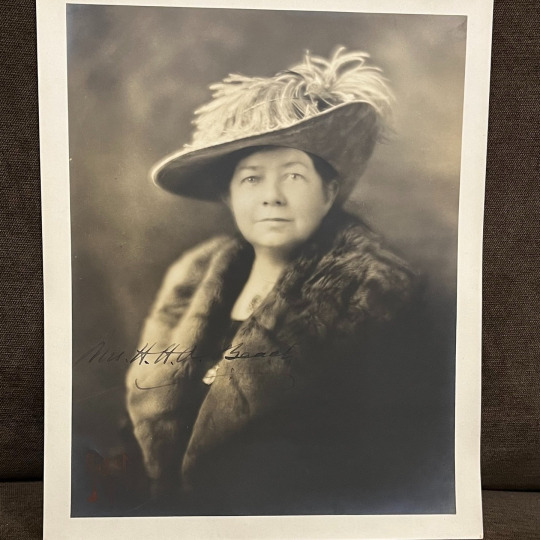
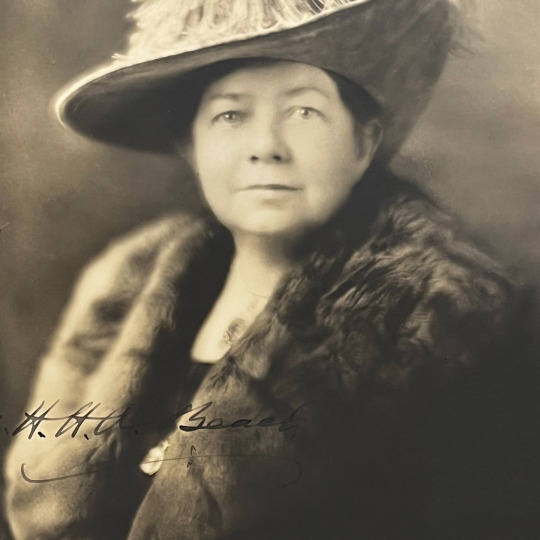
OTD in Music History: Notable American pianist and composer Amy Beach nee Cheney (1867 – 1944) is born in New Hampshire. A historically important musical pioneer, Beach was the first successful American female composer of large-scale “classical” music – her “Gaelic Symphony,” premiered by the Boston Symphony Orchestra in 1896, was the first symphony ever composed and published by an American woman. Against the odds, Beach managed to become one of the most respected and acclaimed American composers of her era. The only female member of the so-called “Second New England School” (alongside such noted American composers as John Knowles Paine, Arthur Foote, George Chadwick, Edward MacDowell, George Whiting, and Horatio Parker), Beach’s writing is primarily in a lush Romantic idiom, although in some of her later works she experimented with more “exotic” or “advanced” harmonies and compositional techniques. PICTURED: A portrait photograph showing the middle-aged Beach, which she signed for a fan. The signature here reads "Mrs. H.H.A. Beach" because, in 1885, Beach married Dr. Henry Harris Aubrey Beach (1843–1910), a prominent Boston surgeon, Harvard lecturer, and amateur singer twenty-four years her senior (Beach was just eighteen on her wedding day). In accordance with the customs and expectations of that era, she thereafter used the name "Mrs. H.H.A. Beach" for all professional purposes. In her own private correspondence, however, she continued to regularly use her given first name. An interesting example (coming in the form of correspondence with another notable American feminist and arts philanthropist) can be seen here:
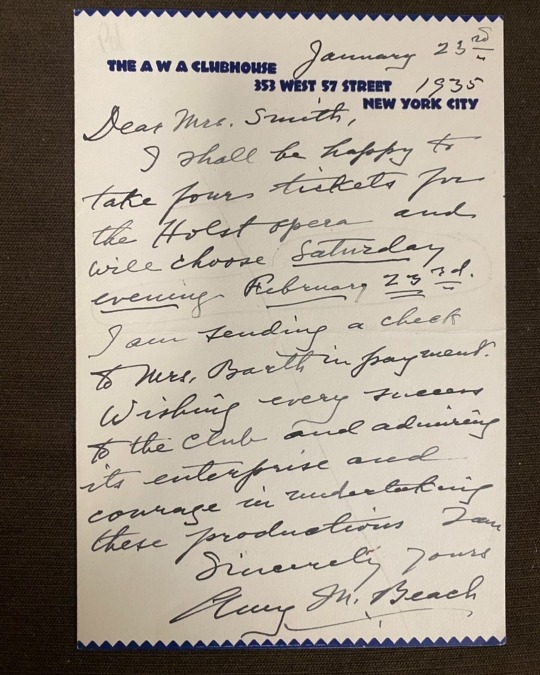
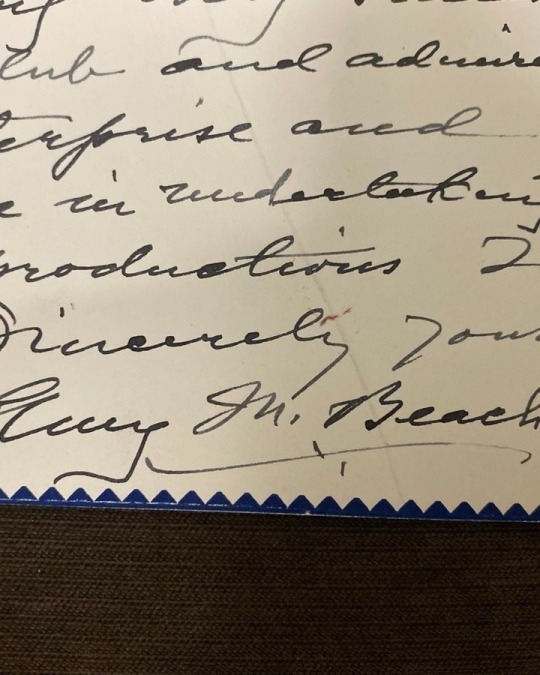
#Amy Beach#classical music#music history#composer#classical composer#classical studies#art music#Gaelic Symphony#Symphony#Chamber music#opera#bel canto#aria#diva#prima donna#maestro#chest voice#classical musician#classical musicians#classical voice#classical history#historian of music#Piano Concerto#Piano#Concerto#Concert#Sonata#songs#musician#musicians
2 notes
·
View notes
Photo
Julia Margaret Cameron (1815–79) was one of the most important and innovative photographers of the 19th century. Her photographs were rule-breaking: purposely out of focus, and often including scratches, smudges and other traces of the artist’s process. Best known for her powerful portraits, she also posed her sitters – friends, family and servants – as characters from biblical, historical or allegorical stories.
Born in Calcutta on 11 June 1815, the fourth of seven sisters, her father was an East India Company official and her mother descended from French aristocracy. Educated mainly in France, Cameron returned to India in 1834.
In 1842, the British astronomer Sir John Herschel (1792 – 1871) introduced Cameron to photography, sending her examples of the new invention. They had met in 1836 while Cameron was convalescing from an illness in the Cape of Good Hope, South Africa. He remained a life-long friend and correspondent on technical photographic matters. That same year she met Charles Hay Cameron (1795–1880), 20 years her senior, a reformer of Indian law and education. They married in Calcutta in 1838 and she became a prominent hostess in colonial society. A decade later, the Camerons moved to England. By then they had four children; two more were born in England. Several of Cameron’s sisters were already living there, and had established literary, artistic and social connections. The Camerons eventually settled in Freshwater, on the Isle of Wight.
At the age of 48 Cameron received a camera as a gift from her daughter and son-in-law. It was accompanied by the words, ‘It may amuse you, Mother, to try to photograph during your solitude at Freshwater.’ Cameron had compiled albums and even printed photographs before, but her work as a photographer now began in earnest.
The Camerons lived at Freshwater until 1875, when they moved to Ceylon (now Sri Lanka) where Charles Cameron had purchased coffee and rubber plantations, managed under difficult agricultural and financial conditions by three of their sons. Cameron continued her photographic practice at her new home yet her output decreased significantly and only a small body of photographs from this time remains. After moving to Ceylon the Camerons made only one more visit to England in May 1878. Julia Margaret Cameron died after a brief illness in Ceylon in 1879.
Cameron’s relationship with the Victoria and Albert Museum dates to the earliest years of her photographic career. The first museum exhibition of Cameron's work was held in 1865 at the South Kensington Museum, London (now the V&A). The South Kensington Museum was not only the sole museum to exhibit Cameron’s work in her lifetime, but also the institution that collected her photographs most extensively in her day. In 1868 the Museum gave Cameron the use of two rooms as a portrait studio, perhaps qualifying her as its first artist-in-residence. Today the V&A’s Cameron collection includes photographs acquired directly from the artist, collected later from various sources and letters from Cameron to Sir Henry Cole (1808–82), the Museum’s founding director and an early supporter of photography.
This photograph is part of the Royal Photographic Society Collection at the V&A which also includes fragments of Cameron's original autobiographical manuscript for Annals of My Glass House.
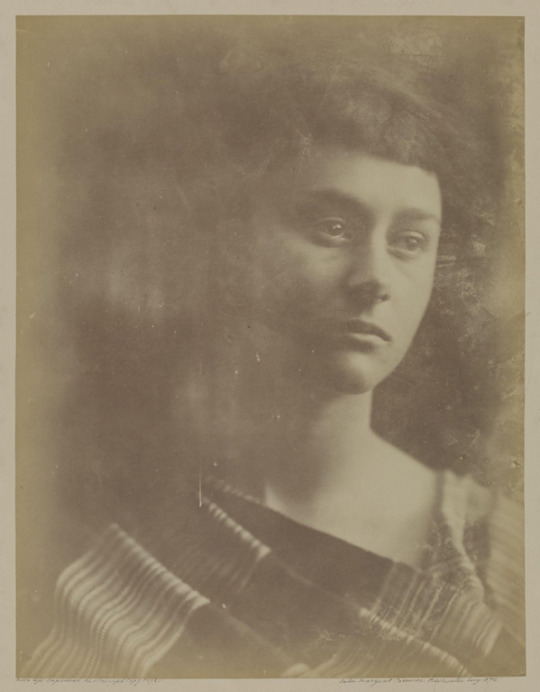
Alice Liddell (August 1872).
Albumen print by Julia Margaret Cameron (1815 - 1879).
Image and text information courtesy V&A.
© Victoria and Albert Museum, London 2017. All Rights Reserved.
#history#photography#art history#museums#literature#britain#england#sri lanka#isle of wight#london#ceylon#freshwater#victoria and albert museum#south kensington museum#julia margaret cameron#john herschel#charles hay cameron#henry cole#alice liddell#lewis carroll#alice's adventures in wonderland
43 notes
·
View notes
Text

Portrait of Lady Katherine Grey and her son, Edward Seymour, Lord Beauchamp.
Artist unknown, c. 1562.
When Elizabeth I died in 1603, James VI of Scotland – son of the executed Mary, Queen of Scots – succeeded her as king of England. According to the last will and testament of Henry VIII, however, there was another candidate with ‘most right’ to succeed Elizabeth: Edward Seymour, Lord Beauchamp, son of Lady Katherine Grey. Katherine's royal lineage traced back to her grandmother, Henry's sister, Mary. So, why were Henry's directions for the succession to the throne not adhered to?
During the early years of Elizabeth’s reign, Katherine – sister of the young, innocent and politically-manipulated Lady Jane Grey, "Queen for Nine Days" who was beheaded in 1554 on charges of treason – was regarded by many at court as heir presumptive. However, from the moment she came to the throne, Elizabeth made it clear that she ‘could not abide the sight' of Katherine. Tudor historian Tracy Borman explains that: “Highly sensitive to questions over her own legitimacy, Elizabeth naturally distrusted any other persons of royal blood, particularly those whose place in the succession had been confirmed by Act of Parliament – as Katherine’s had.”
Katherine further incurred Elizabeth’s displeasure when in 1560 she secretly married Edward Seymour, 1st Earl of Hertford, nephew of Henry VIII’s third queen, Jane Seymour and son of Edward Seymour, 1st Duke of Somerset (click here for previous post re. Seymour Sr.). Borman says Katherine lacked the political guile to chart the dangerous waters in which she found herself and describes the step of marrying Edward as “reckless”. For a person of royal blood to marry without the monarch’s consent was treasonous, and when Elizabeth heard of it she wasted no time in imprisoning Katherine (who was already pregnant) and her new husband in the Tower of London, where Jane had been executed.
In September 1561, Katherine gave birth to a son. The boy was christened in the Tower’s Chapel of St Peter ad Vincula, under the flagstones of which lay his aunt's bones. The birth of a male heir to Katherine only intensified Elizabeth’s fury, and she ordered that she and her husband be kept strictly apart. But their gaolers evidently took pity on them because, in February 1563, Katherine gave birth to a second son in the Tower.
Borman: “When Elizabeth found out, her fury knew no bounds. The Spanish ambassador observed that she turned ‘the colour of a corpse’. She ordered that Katherine and her husband be removed immediately from the Tower and sent to different places of imprisonment, many miles apart. She also levied the colossal fine of £15,000 on Seymour (equivalent to £3.5 million today)”. Heartbroken at being separated from her beloved husband - they were never to meet again - Katherine’s health suffered a serious decline, exacerbated by her refusal to eat, and she died in January 1568 at the age of 27.
By the time Elizabeth died thirty-five years later, Katherine’s first son, Edward Beauchamp, was the senior qualified heir under Henry VIII’s will. It had stipulated that the elder line of the Tudor dynasty, descended from his sister, Margaret Tudor, should be passed over in favour of the younger line, descended from Mary Tudor, the king’s younger and favourite sister. Had the stipulations of the king’s will been carried out, Edward would have become “King Edward VII”, and England and Scotland would not have been placed under a personal union. However, Elizabeth’s rancour had resulted in a commission declaring Katherine's marriage with Seymour unlawful and their sons illegitimate, thereby neatly overriding Henry’s wishes.
The succession progressed in favour of the elder line. Margaret Tudor's son was James V of Scotland; his daughter was Mary, Queen of Scots who was only six days old when her father died. As Mary was beheaded on Elizabeth's orders in 1587, the next in line was her son, James, who was already James VI of Scotland. He acquired the kingdoms of England (which included Wales) and Ireland as James I, thereby bringing the monarchy under the rule of the House of Stuart. The last Stuart monarch, Anne (1665 – 1714), was to see the creation of Great Britain in 1707.
Sources:
Conor Byrne ‘Lady Katherine Grey: A Dynastic Tragedy’
Tracy Borman: ‘The Tragic Story of Lady Katherine Grey’ on the Historic Royal Palaces website (link here)
And, erm, cough, Wikipedia!
NEEDS CHECKING
0 notes
Note
Am I the only one thinking William comes out of this looking pretty decent?
Harry has declared himself King Harold, the new King Henry IV, ready to destroy his brotherly arch nemesis
William has apparently kept him at arms-length for some time, and instead has normal relationships with supportive friends that he wanted to speak at his wedding reception
William stood up for his wife, and was even prepared to get physical with Harry over the fact Meghan was making the staff cry, making his daughter cry, and needling Kate constantly
He hasn't responded to Harry making lurid and unnecessary descriptions of his genitals (and their parents private medical decision to circumcise or not)
William has always spoken of his mother respectfully and has sought to minimise those trying to profit off the continual drama surrounding her life and death
He advised Harry to carefully consider who he should marry and never to rush into things
He expected Harry to behave like all the military men in the family and senior-ranking officers by adhering to correct dress, including being clean-shaven
Despite Harry's apparent wishes, William did not lustily throw himself at his brother's new gf for a welcoming bear hug and would have probably been content with a hand shake
William has never publicly commented on either of his parents' affairs, or his father's remarriage, or dissed Camilla
William has never blamed his brother for anything he himself did
I don't think he comes out bad at all, due to everything in your list. Harry has behaved abominably and his credibility is shot. Plus the lack of response itself belies the "red mist William" portrait Harry is trying to paint.
204 notes
·
View notes
Photo

There are so many amazing bottom Louis fics that were posted or completed during the month of December. We’re entering a new year feeling incredibly grateful for the amazing fics we got in 2022, and excited for the many we’ll get in 2023! Happy reading!
1) Far From Reality | Explicit | 1138 words
Note: The main pairing is Louis/Henry Cavill.
Henry and Melissa looked like the perfect couple. Nothing could be further from the truth.
2) Honeymooning In Italy | Not Rated | 2386 words
Honeymoon sex.
3) Poisonous Ivy | Explicit | 3241 words
Louis is a starving man.
He craves many things in his life. Mainly of those things that he is hungry for are things that had been deprived off of him.
4) Flame Colored Paradise | Explicit | 3282 words
Note: The main pairing is Louis/Mads Mikkelsen.
A side smirk widened Mads’ lips. He looked like a sight straight from heaven in his dark three-piece suit, hair in perfect place, a relaxed look on his face, as if he hasn’t had a hard-on for the last half an hour. Louis loved how Mads was always perfectly composed, never a single strand of hair out of place. He could have his whole cock buried in Louis, with the boy falling to pieces in front of him, but not a single drop of sweat would dampen his face.
5) Alpha Heater For Sale | Ten & Up | 3626 words
He passed by the bulletin board in the hallway, as usual, flyers about open mics, dorm events, and the like. This time though, he stopped when a flyer caught his eye. The words “alpha” and “heat” calling out to him.
Louis tilted his head at the flyer curiously.
It read: Alpha heater for sale! Winter weather got you down? Call Harry for your warm, furnace-like needs!
6) Unspoken | Explicit | 5175 words
Harry and Louis broke up when they were nineteen. They see each other after six years.
7) You're The (Devil In Disguise) | Explicit | 5179 words
Louis is, in appearances, the perfect omega. Small, graceful, docile, polite and very sweet. At least, until the rebellious side of him comes out, which sends alphas running away.
8) Little Minx | Mature | 5514 words
Harry’s new flatmate Louis seems to have a growing problem…literally.
9) Down Comes The Night | Explicit | 5974 words
Note: The main pairing is Louis/Pedro Pascal.
A love story set in the 18th century. Pedro is a painter, commissioned to create a wedding portrait of Louis, a young man who has just left the convent. Louis is a reluctant spouse to be and Pedro must paint him without his knowledge.
10) Our Stained Skin | Explicit | 6019 words
When Louis' 8-year-old daughter shows up with a tattoo on her arm Louis needs to get to the bottom of it. That may or may not involve him tailing someone. But at least he has a good reason for it. Sort of.
11) Forever Is Composed Of Nows | Not Rated | 6598 words
There was one time of the year that Louis loved more than any other. It came on the heels of autumn, slowly at first in frosted blades of grass and misty mornings and then swept over the countryside in sheets of freshly fallen snow glinting in the sunlight. With its arrival came the glow of multi-colored strings of lights strung from the eaves of every home and a magic in the air that filled the lungs of awe-inspired pups craning their necks to take in the festive displays.
Harry and Louis spend Christmas Day together.
12) Can We Please Get Back to Fucking? | Explicit | 8370 words
Harry and Louis have had a toxic back-and-forth relationship since they hate fucked at freshman orientation. Now in their senior year, they’ve lost count of how many times they’ve broken up and gotten back together. This is a smutty one-shot from when Louis makes Harry jealous at a club. Harry takes back what is his, and they fuck in the bathroom.
13) Singer And Photographer | Not Rated | 15361 words
Harry Styles: singer, songwriter, alpha
Louis Tomlinson: photographer, omega
What if you get invited by one of your best friends to join him and his band on tour?
What if you are photographing the tour?
What if you're slowly falling in love with a special alpha?
14) Here Where You Should Be | General Audiances | 19497 words
When Harry, an anxious alpha, found himself panicking over last minute Christmas shopping, he found comfort in the kind omega shop assistant, Louis. He wasn't meant to invite the omega home for Christmas when he found out that he's spending Christmas alone. He wasn't meant to catch feelings. Hell, he wasn't even meant to be able to go home for the holiday. It was shaping up to be a Christmas full of surprises.
15) Under The Rain Or Under The Snow | Explicit | 20667 words
“I don’t think I understood.” He shakes his head and closes his eyes, as if distancing himself from the situation. “Harry? What the fuck are you doing here?”
“Your mum invited me, also, how could I say no to her superb roast potatoes?”
16) 12 Days of Courting | Explicit | 22709 words
They're friends with benefits and Louis' heat is scheduled for Christmas.
17) The Evenness I Fake | Explicit | 26385 words
Harry doesn’t do relationships. He has a perfectly enjoyable friends-with-benefits agreement with a perfectly lovely omega, and he doesn’t see the need to change that anytime soon. The small fact that Louis giving his attention to another alpha makes Harry want to put his head through a wall isn’t nearly as much of an issue as everyone’s making it out to be.
18) Something Along The Lines Of ‘An Office Love Story At Christmas’ | Explicit | 43148 words
Harry hadn't planned on seeing Louis again, not after that night. When he finds out his only competition for a very desired promotion is Louis, he spirals into a mess of trying to be a better coworker and person right before Christmas in hopes that he can outdo Louis' effortless effect on his office. If he manages to get his head out of his ass along the way, it’ll be a holiday miracle.
19) All I want For Christmas Is You | Not Rated | 43253 words
Christmas AU in which a soft alpha with gorgeous green eyes and an even prettier smile moves into Louis' apartment complex and turns the omega's world upside down during his most favourite time of the year - featuring christmas decorating, christmas markets, cookies in the making, and copious amounts of mulled wine (and kisses).
20) Your Gift is Wasted On Me | Not Rated | 54472 words
“He had a partner for a long time, and he says that he was too dependent. He doesn’t want an alpha, at least not right now. But he’s got a pretty severe case of touch deprivation. So it’s … not great.”
“Is there anything …”
“He doesn’t like to be touched. There was an incident a few weeks ago and he just … he can’t bear human touch.”
21) Now I'm Begging for Footnotes In The Story of Your Life | Explicit | 80742 words
Harry and Louis are engaged, but a few months before the wedding Louis realises that they don't like each other, so instead of ending the engagement two of them go head-to-head in an all out prank war.
In the battle of who will end the engagement first.
22) You Sunshine, You Temptress | Explicit | 88148 words
A story about a forbidden love
& secrets that come to light.
Eyes as green as the forest And eyes as blue as the lake When they met a love began
Stronger than the tide And wilder than a river Fearless Despite the ban
Fairy and wolf Together one
23) My Kind Of Love | Explicit | 108178 words
Harry marries Louis for one year. Louis has no choice other than marry Harry fucking styles. There is a reason behind Harry’s sudden marriage with Louis and Louis has no idea about that. Maybe Harry married Louis for revenge.
Check out our other fic rec lists by category here and by title here.
You can find other monthly roundup fic rec lists here.
126 notes
·
View notes
Text
edward plantagenet, the earl of warwick, was born in 1475, the only son of george plantagenet, duke of clarence. his mother died a year later, and he was orphaned by his uncle, edward iv, two years after that, when edward executed his brother george for treason. for the remainder of his uncle's reign he was an orphaned child and a political nonentity. in 1483 edward iv died and was succeeded by edward v, who subsequently disappeared; warwick then became an important political player because he was one of only three - and then only two - male-line plantagenet men left alive. he was also the senior plantagenet left alive - his father, george, was older than richard iii, and richard barred him from claiming the throne because of his father's attainder. he was kept in custody (though not imprisoned) by richard until richard's own death at bosworth, leaving him the sole remaining plantagenet boy. he was imprisoned by henry vii in the tower of london, and only released briefly to be taken around london as proof that he was still alive and that lambert simnel was not the earl of warwick. eventually, he was executed in 1499, at the age of twenty-four, probably to ensure that the marriage of prince arthur and katherine of aragon could go ahead, and to eliminate a threat to henry vii's rule. he never married (because he was raised in the tower of london), posed no real threat to henry vii (because he was imprisoned in the tower of london), and was reported to be insane by one man (because - wait for it! - he had been raised in the tower of london).
we have one sketch of him in armour, and no portrait. he had no children and no family except his sister and cousins. and also his uncles, who were not exactly helpful. he was raised in the same tower that two of his cousins had disappeared in, and that another two cousins (and his sister!) would go on to die in. he was the last plantagenet man, and he was executed in his twenties.
and that's it.
that's all we know about him.
we don't know anything about his personality. we don't know what he thought of any of this. we don't even really know what he looked like. he is commonly forgotten as the last plantagenet in favour of richard iii, who was very simply the last plantagenet king - though of course monarchy is fake and dynasties are arbitrary.
he is a shadow of a person. we know he existed, what his life was like - and little more. there's nothing sentimental there, nothing personal. and this is true of so many people - the barest scrap of a hint at a person; a name, a date, a missing portrait. the vast majority of people are totally forgotten, but for some people we have these little remnants of a person erased, or lost, or destroyed to cling onto.
it's inevitable, but it never stops being heartbreaking.
do you ever get sad about the people whose lives have disappeared from history? not entirely. not completely. but enough that we have only the barest traces of a person. an outline, a copied portrait, hearsay and chinese whispers; but not a person. just the scraps they left behind.
48 notes
·
View notes
Text
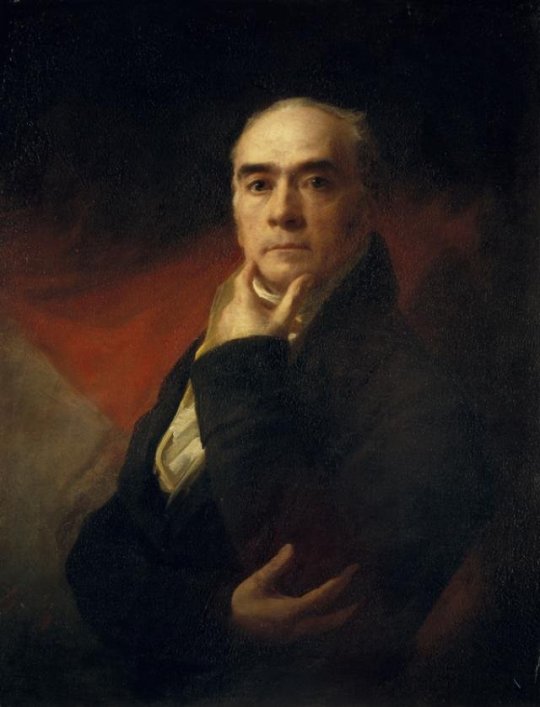
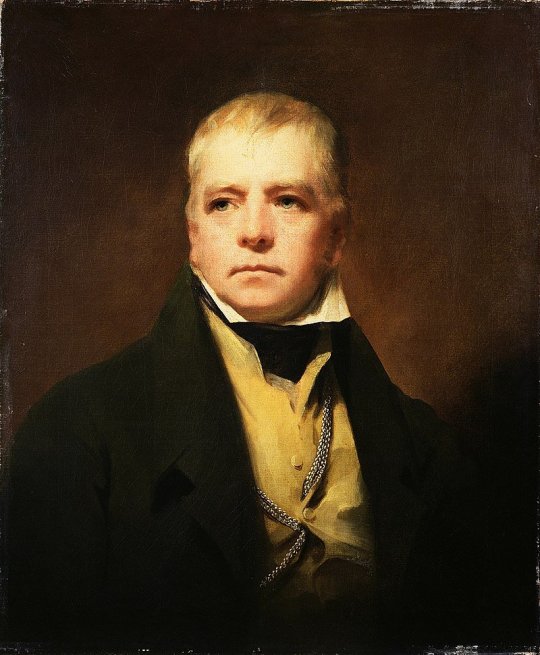
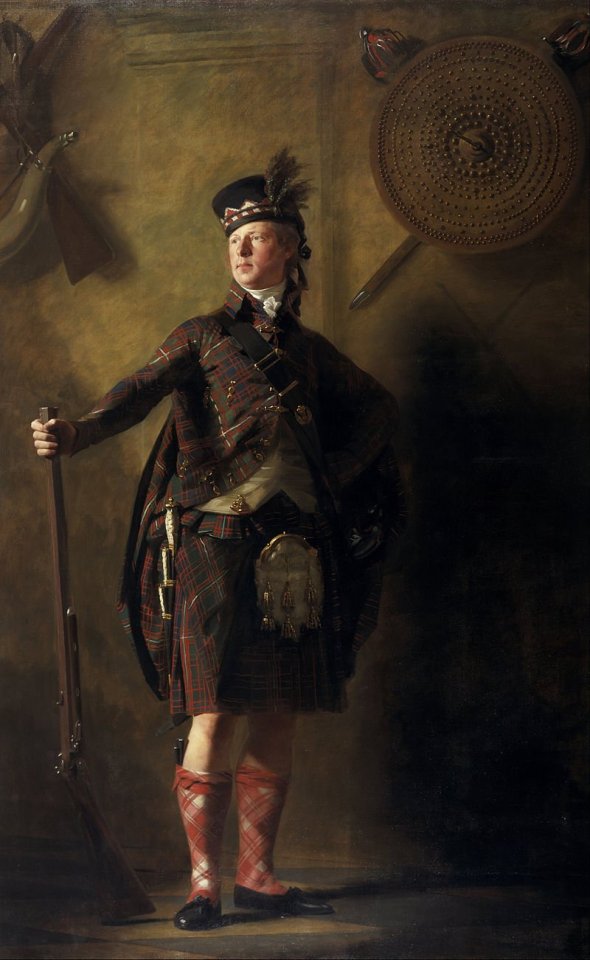
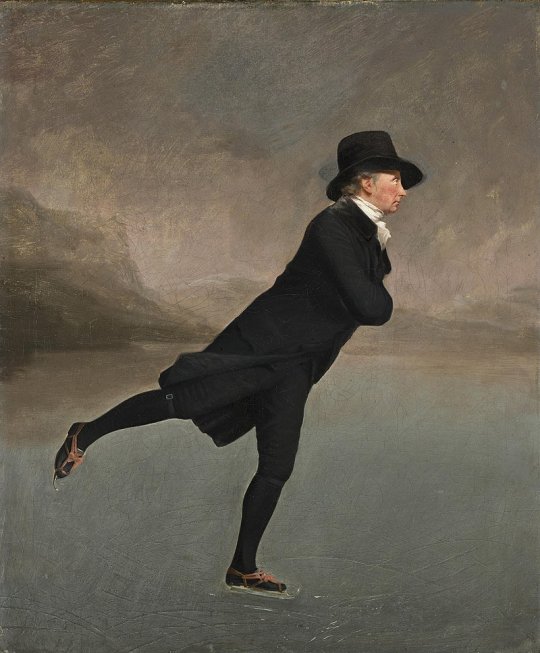
On July 8th 1823, the renowned artist, Sir Henry Raeburn, died.
Sir Henry Raeburn is perhaps the best known of all Scottish painters. He was almost exclusively a portraitist and his career was wholly in Scotland, mainly in Edinburgh. His small full-length portrait of the Rev Robert Walker Skating on Duddingston Loch, of about 1784 is probably his most famous work.
Henry Raeburn was born in Edinburgh, the son of a successful businessman who prepared yarn for the wool trade. However, both of Raeburn’s parents died in the early 1760s, leaving the young Raeburn in the care of his brother William, 12 years his senior. William took over the family yarn business and his younger brother was enrolled at George Heriot’s Hospital in 1765, then a school for the education of orphaned children of tradesmen.
During his schooling, Raeburn demonstrated particular aptitude for manual craftsmanship and he became apprenticed to a goldsmith, James Gilliland in 1772. At some point in his time in Gilliland’s jeweller’s workshop, Raeburn started painting portrait miniatures. Following his apprenticeship, Raeburn embarked upon a career as a portraitist while also attending drawing classes involving drawing from the Antique and from a draped model.
In the late 1770s, Raeburn married Ann Leslie Edgar, a wealthy widow who brought property and two daughters to the marriage. After the birth of two sons in 1781 and 1783 respectively, Raeburn began to plan for an extended stay in Rome, which he believed would provide artistic development and commercial success.
Arriving in Rome in late 1784, Raeburn made contact with fellow Scot James Byres, who provided guidance for Britons travelling on the Grand Tour. Byres also provided Raeburn with patrons and the chance to meet notable artists, such as Pompeo Batoni.
On his return to Scotland in 1786, Raeburn began producing impressive portraits for members of the Edinburgh elite, quickly establishing his reputation as the pre-eminent Scottish portraitist. During the 1790s, Raeburn developed his own unique style characterised by strong lighting from behind the sitter and dispersing across the canvas. He was in such high demand as a portraitist that he outgrew his studio in George Street, the fashionable and burgeoning central thoroughfare of Edinburgh’s New Town and, around 1800, moved to a grand house nearby with reception areas, a framer’s workshop and a studio that took up the entire first floor. In these new premises Raeburn produced a series of full-length portraits of Highland chiefs and lairds in Scottish military dress which drew particular attention when exhibited in London.
From 1805, Raeburn was involved in a trading company called Henry Raeburn & Co., that operated from the port of Leith, trading mainly with London. He also became a director of the Caledonian Insurance Company in 1806, but his finances were far from secure. At the start of 1808, Raeburn was declared bankrupt. The cause of his financial ruin is not entirely known but by mid-1808 he had £36,000 in claims against him. Raeburn vowed to spend the rest of his life repaying these debts and untangling his financial difficulties, which were intertwined with family, as his son and step-son-in-law were partners in his trading firm.
In 1810, Raeburn sought to resolve his financial difficulties by moving to London. His fellow painter and countryman David Wilkie had relocated there years earlier successfully, but unfortunately, Raeburn’s attempt to find riches in the London art scene did not work and he returned to Edinburgh later the same year.
Despite his lack of success in London, Raeburn was elected an Associate of the Royal Academy in 1812 and became a full Member in 1815. An embarrassing miscommunication meant that the self-portrait Raeburn had gone to great lengths to prepare as his Diploma work, was refused by the Royal Academy due to their embargo on accepting self-portraits as Diploma works. Raeburn was sorely disappointed, and instead submitted a portrait of his grandson Henry Raeburn Inglis, Boy with a Rabbit. There is evidence in his correspondence that Raeburn felt frustrated at his isolation from the London art establishment, that he could not find success there as he did in his native Edinburgh.
After 1808, Raeburn’s paintings suffered from his prolific output and urgency to produce work to repay his creditors. Many portraits from this time appear hastily finished or lack depth. However, he also managed to produce some of his most sensitive and affecting paintings, and he was particularly adept at painting children.
In the final years of his life, Raeburn was lauded with honours and accolades, becoming a member of the American Academy of Fine Arts in 1819, a fellow of the Royal Society of Edinburgh in 1820, being knighted in 1822 and appointed as Painter and Limner to King George IV in 1823.
Raeburn died unexpectedly on this day in July 1823, following a visit to Fife where he probably contracted a fever.
His posthumous reputation grew with a number of exhibitions in the 19th century, and his paintings were highly sought-after as part of the early 20th-century American craze for British art; Raeburn’s works feature in several public museums and private collectors in the US and around the world today.
Pics are his self portrait, Sir Walter Scott, Alexander Ranaldson MacDonell of Glengarry and The Skating Minister
7 notes
·
View notes
Photo

Short Timers on Ancient Coins: The Briefest Reigns of Roman Emperors
UNEASY LIES THE HEAD THAT WEARS A CROWN.
—SHAKESPEARE, HENRY IV, PART II (1597)
ROMAN EMPERORS RARELY wore an actual crown. They are more commonly shown wearing a laurel wreath or a diadem, the jeweled headband that was an ancient emblem of royalty. But the mortality statistics were enough to make any imperial head uneasy. Over 70 percent died by assassination, suicide, or in combat. Between 27 BCE and 395 CE, the average length of an emperor’s reign was just 5.6 years. But many lasted for a much shorter span of time.
Yet Roman mints were so efficient that even in a reign of a few weeks, it was possible to produce an extensive coinage, often with lifelike portraits of the ruler and his family. Every new ruler knew it was important to show the people his face on their money. Some of these coins are quite rare, but many are surprisingly common and affordable today.
Gordian I and II: 21 Days:

Armies in all eras tended to promote big men; their physical size and strength commanded respect and obedience.
Maximinus Thrax was a giant, eight feet tall (2.4 meters) according to the notoriously unreliable Historia Augusta. Of peasant stock, he rose through the ranks to command a legion on the northern frontier, and in 235 CE his mutinous troops murdered the Roman emperor Alexander Severus and his powerful mother, Julia Maesa. The army proclaimed Maximinus the new emperor, and the Senate grudgingly assented.
Like many rulers of humble origin, he hated aristocrats and made the mistake of alienating the Senatorial elite without exterminating it. He never set foot in the city of Rome and may have been illiterate (unusual for a third-century legionary officer). In 238 (the famously chaotic “Year of Six Emperors”), the province of Africa (today Tunisia and part of Algeria) rose in revolt against Maximinus. Leading the rebellion at Carthage was a distinguished elderly provincial governor, Marcus Antonius Gordianus Sempronianus. The Senate quickly recognized him as Emperor Gordian I “Africanus”. Because of his advanced age (about 80), he insisted on making his adult son co-emperor as Gordian II. The governor of Numidia (now parts of Algeria and Morocco) remained loyal to Maximinus and advanced against Carthage. Gordian II was killed in battle and his father committed suicide after a reign of just 21 days (March 22 – April 12, 238).

Incredibly, three weeks was sufficient time for mints at Rome and Alexandria to produce an extensive coinage in the names of both Gordians, bearing their portraits. A denarius of Gordian I currently brings between $1,500 to $3,000 USD at auction, while one of Gordian II can sell for twice as much. The inscriptions for the father and the son are identical but the portraits are distinctively different.
Numismatist David Vagi writes:
The elder Gordian has a full head of hair, a thin face, a beaked nose, and a slightly recessed jaw. The younger Gordian has a receding hairline, a long flat nose, a pronounced forehead, heady jaw and jutting chin, and is fleshier in appearance.
Diadumenian: About 1 Month:
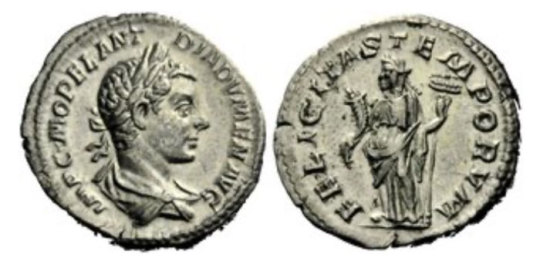
The fate of child emperors was often tragic.
Born in 208, Marcus Opellius Antoninus Diadumenianus was the son of Macrinus, who was Praetorian Prefect (palace guard commander and senior advisor) to Emperor Caracalla. Macrinus seized the throne after murdering Caracalla. At the age of eight, Diadumenian received the title of Caesar – in effect, heir apparent. Caracalla’s aunt influenced the troops of the eastern legions to proclaim her 14-year-old grandson, Elagabalus, as emperor, using the rumor that the boy was actually Caracalla’s son. At some point, Macrinus promoted his own son to Augustus (co-emperor).
Defeated in battle near Antioch, on June 8, 218, Macrinus was captured and executed. With a few trusted guards, Diadumenian fled to seek sanctuary in the Parthian Empire but was intercepted and beheaded at the age of 10. His head was sent as a trophy to Elagabalus, who himself was only a few years older.
Coins of Diadumenian as Caesar are scarce, but those of his brief reign as Augustus (perhaps less than a month) are extremely rare. In a 2014 Swiss auction, a denarius – one of just four known – sold for over $38,000.
Didius Julianus: 66 Days:
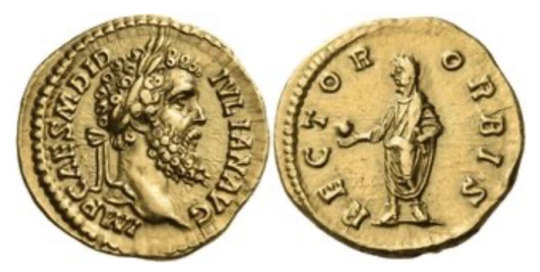
On March 28, 193, disgruntled Praetorian guards stormed the imperial palace and murdered the stern emperor Pertinax, who had reigned for only 86 days (see below). The 18th-century English historian Edward Gibbon elegantly recounts what happened next:
The more prudent of the Praetorians ran out upon the ramparts; …and, with a loud voice, proclaimed that the Roman world was to be disposed of to the best bidder by public auction. This infamous offer, the most insolent excess of military license, diffused a universal grief, shame, and indignation throughout the city. It reached at length the ears of Didius Julianus, a wealthy senator…
Senator Didius Julianus and another man, Sulpicianus (the father of the murdered emperor’s wife, Titiana), began to bid ferociously against each other for the throne. Julianus won the auction with an extravagant promise of 25,000 sestertii for each of the 8,000 guardsmen. Romans of this era commonly expressed large sums of money in terms of the bronze sestertius. The winning bid was equivalent to 6,250 silver denarii, or 250 gold aurei per man!
Julianus quickly ordered the mint to produce coins promoting his imperial reign and honoring his wife, Manlia Scantilla, and daughter, Didia Clara. On the reverse of his gold aureus, he holds a globe and proclaims himself RECTOR ORBIS – “Master of the World.” Nervous about the loyalty of his army, his most common reverse type is CONCORDIA MILITUM – “Consent of the Soldiers.”
Julianus proved deeply unpopular, and civil war loomed as three major armies revolted against him, led by Clodius Albinus in Britain, Pescennius Niger in Syria, and Septimius Severus in Pannonia on the Danube. Severus won the race for Rome and Julianus, deserted by the Praetorian Guard (which had yet to receive its promised payment), was deposed by the Senate, captured, and beheaded.
During a reign of just 66 days, the mint of Rome managed to turn out three different types in gold, three in silver, and six in bronze!
Pertinax: 86 Days:
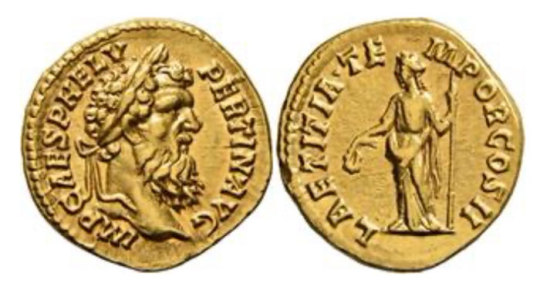
Born in the year 126, Publius Helvius Pertinax was the son of a slave who gained his freedom and prospered in the wool trade, providing a good education for his son, who then rose through the ranks of the army and became a senator and provincial governor. Following the assassination of Commodus on the last day of the year 192, Pertinax was chosen by the Praetorian Guard to become emperor.
A capable and responsible ruler, Pertinax restored the weight and quality of the silver coinage, which had deteriorated under the previous emperor. His attempts to reduce corruption and impose military discipline on the unruly Praetorians were resisted, and he was murdered after a reign of just 86 days.
During this brief time, the mint of Rome managed to issue six types in gold, 10 in silver, and 13 in bronze! A common reverse type was PROVIDENTIA DEORVM (“Providence of the Gods”), depicting the standing female personification of “providence in the sense of a prescient power caple of creating or altering future events.”
Otho: 92 Days:
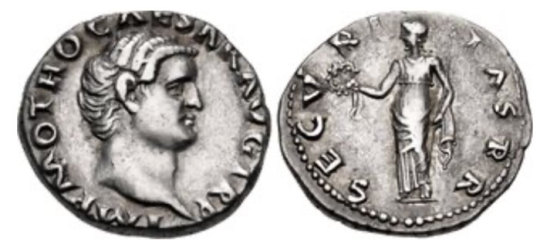
OTHO, WHO IS DESCRIBED BY TACITUS AS “AN EXTRAVAGANT YOUNG MAN”, WAS RENOWNED FOR HIS EFFEMINACY AND VANITY, AND WAS PARTICULAR ABOUT HIS GROOMING. HE IS FAMOUS TO NUMISMATISTS FOR HIS WELL-MADE TOUPEE, WHICH APPEARS AS A LUXURIANT HEAD OF HAIR ON HIS IMPERIAL PORTRAITS (VAGI, 189).
Remembered as the “Year of Four Emperors”, 69 CE was a chaotic period that followed the suicide of Nero.
On January 15, Marcus Salvius Otho organized a coup that overthrew and killed his former friend, the emperor Galba. Otho’s unusual name was of Etruscan origin. Nero had forced Otho to divorce his wife, the beautiful Poppaea Sabina, so that Nero could marry her, and sent him to govern distant Lusitania (now Portugal).
Soon, however, the powerful Roman army on the Rhine frontier marched on Rome, determined to depose Otho. When his army was defeated in Northern Italy, Otho committed suicide on April 16 or 17. He was 36 years old.
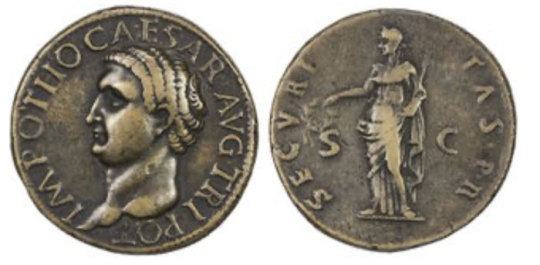
With a reign of just three months, Otho issued only gold and silver coins. The most common reverse, inscribed SECVRITAS, bears the personification of “Security”. Some elegant bronze fantasies were created during the Renaissance to fill the demand for sestertii of Otho. These fakes can be quite affordable.
For collectors determined to complete a set of the “Twelve Caesars”, Otho is one of the most challenging rulers, since coins in high grade are very scarce. A silver denarius in Very Fine condition currently goes for about $1,000 to $3,500, while a gold aureus brings anywhere from $10,000 to well over $100,000 depending on grade.
Aemilianus: 2-3 Months:

Born in Mauretania in Africa about the year 208, Marcus Aemilius Aemilianus was commanding the legions on the Danube when his troops, rebelling against the unpopular Trebonianus Gallus, proclaimed him emperor in August 253. When Aemilianus invaded Italy, Gallus and his son Volusian were murdered by their own troops – a common fate of third-century emperors.
In Aemilianus’ reign of two or three months, the mint of Rome struck three types in gold, over 20 types in silver, and about 13 types in bronze for Aemilianus. A few very rare silver antoniniani were issued in the name of his wife, Cornelia Supera, who is otherwise unknown to history. Ironically for this war-torn era, many reverses honor Pax, goddess of peace. When another general, Valerian, was proclaimed emperor by his army and invaded Italy, Aemilianus was murdered at a bridge near Spoleto that came to be known as Pons Sanguinarius (“Bloody Bridge”).
Marius: 2-3 Months:
In the turbulent year 269 CE, a blacksmith who had risen through the ranks of the Roman army on the Rhine was proclaimed emperor by his troops under the name “Marcus Aurelius Marius”. He reigned for just two or three months before he was executed–according to legend, his end came at the edge of a sword he had forged in his previous career.
In this short reign, a considerable volume of coinage – mostly silvered bronze – was produced, probably to pay the troops. These coins of Marius are quite affordable. Only about nine gold aurei of Marius exist, seven in museums.
Florianus: Less than 3 Months:
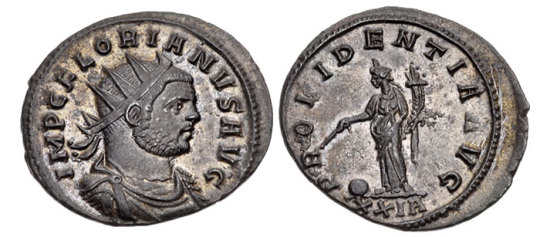
Born in 232 CE, Marcus Annius Florianus (or “Florian”, still a popular boy’s name in Romania) was the younger half-brother of Tacitus, a distinguished senator who became emperor at the request of the Senate following the murder of Emperor Aurelian in September 275.
When Tacitus died, either from illness or assassination (sources differ), Florianus, then serving as Praetorian Prefect, declared himself emperor. At the same time, Probus, a senior general commanding the powerful armies of the East, was proclaimed emperor by his legions in Syria and Egypt. The inevitable clash came in the mountains of Cilicia, and Florianus was killed by his own disgruntled troops after a reign of fewer than three months.
A silvered bronze antoninianus of Florian in extremely fine condition can be found for under $100, with even the finest Near Mint State examples going for under $500. High-grade examples of the very rare gold aureus sell for as much as $200,000 when one comes to market every few years.
Pupienus and Balbinus: 3 Months:

The death of the two Gordians in 238 (see above) created a power vacuum in Rome.
With the army of Maximinus poised to invade Italy and wreak bloody vengeance on the Senate, the senators responded by electing two distinguished elders, Marcus Clodius Pupienus and Decimus Caelius Calvinus Balbinus, to serve as co-emperors. Pupienus was named first in official inscriptions – a source of irritation to his colleague, who claimed a better aristocratic pedigree. The common people, who loved the Gordians, insisted that a surviving 13-year-old grandson of Gordian I be proclaimed as heir to the throne: the future Gordian III.
On July 29, 238 CE, disgruntled Praetorian guardsmen stormed the palace, dragged out the two co-emperors, and hacked them to death.
In an outburst of creative productivity, the mint of Rome turned out 29 different coin types for Pupienus (one in gold, 14 in silver, and 14 in bronze) and 23 for Balbinus (one in gold, 10 in silver, and 12 in bronze) during this reign of 99 days. Ironically, although the two co-emperors despised one another, a common reverse type is a pair of clasped hands, with the inscription FIDES MVTVA AUGG (“Mutual Trust of the Emperors”).
During this reign, the relatively pure silver denarius was gradually phased out in favor of the debased antoninianus, over-valued at two denarii.

The gold aureus of Pupienus is apparently unique, although there is a well-known forgery by the 19th-century German counterfeiter Karl Wilhelm Becker (1772-1830). Just three gold aurei of Balbinus are known; one brought over $70,000 in a 2005 Swiss auction.
By Mike Markowitz.
#emperor#roman emperor#the briefest reigns of roman emperors#coins#collectable coins#roman coins#ancient coins#history#history news#ancient history#ancient culture#ancient civilizations#roman#ancient rome#roman history#roman empire#long post#long reads
22 notes
·
View notes
Text
Well, That Didn't Last Long
Ok, first things first, I'm playing serious catch up here so you'll have to bear with me if I'm covering things that are in the dim and distant past for you all now. As you know I had one heck of a time trying to regain access to my account then, when I finally did get it back, I caught the flu so have been laid up with that for the past few days. I'm just going to go over the things that have happened as they occur to me and give you my take on them. Here goes:

Yes, no sooner had they landed back in sunny Montecito and heard the news and seen the subsequent portrait of the royal quartet, Our Lady of Perpetual Victimhood shot back with an image of herself and husband Saint Henry of the Wounded Ego taken during their soiree into Manchester for her appearance as the keynote speaker at the One Young World Charity. I'm not a computer whizz but the doctored images doing the rounds are a hoot and well worth a look. I'm sure their "friend" photographer Misan Harriman who took this and other heavily photoshopped (tree of life anyone?) images of the couple would approve. Since the release of the above portrait, it seems that the "charity" which calls itself a "global forum for young leaders" is being investigated for paying Kate Robertson and her daughter Ella McKay almost £2 million in 5 years, some of it during the lockdown periods of Covid when no summits were being held. The Charity Commission is investigating remuneration packages for senior management personnel at One Young World and, although I may be allowing bias to take precedence, looking at the pair in charge, I can only say, why didn't happen sooner. I should point out, there is no suggestion of any impropriety from the Harkles or any celebrities associated with the "charity". One Young World, Markled it would seem. However, back to the point of the photo, it was a knee-jerk reaction to release it when and how she did. It was a fuck you, we're still royal or at least one of us is and we're not going to let you forget it. What it has served to do, is to remind everyone just how bitter Ms Markle can be.
Katie "I saw Him First" Nicholl has a new book out, "The New Royals" and is desperate to plug it and get as many sales as possible. To that end, and with no context whatsoever, she "let slip" a story about Prince George supposedly telling another child at school during a bit of toing and froing "watch out, my dad's going to be king". This opines Katie, makes young George a bit of a brat. The twittersphere went crazy, tumblr went mental, social medias everywhere went into meltdown and poor old Katiekins felt the need to defend herself saying her words had been "taken out of context". Yah think Katie? Would that be because you didn't give them any context? As many of you know, Katie works for Vanity Fair, she very often seems to be a fair minded, even handed, intelligent human being. However, when her mask slips as it did in this instance, you see her for what she is, a mean girl interested only in fame and making money using someone else's name. Remind you of anyone?
Archetypes with Meghan is back *shudder* after a short break following the death of Her Majesty Queen Elizabeth II. This time round, our girl was discussing the stereotyping (someone really should explain the meaning of both words and the differences between the 2 to her) of Asian women in film. By Asian women, Meghan was referring solely to Chinese, Korean and Japanese and possibly Thai, completely ignoring Indian, Pakistani, Israeli, Iranian, Turkish, Lebanese, Sri Lankan, Syrian, Bahrainian and Cambodian to name just some of the 48 countries not including dependencies which make up the continent of Asia. Is her racism showing again? Anyway, this time round, before her guests, Margaret Cho ( Korean-American Comedienne, Actress and Activist) and Lisa Ling (Taiwanese-American journalist, author and television presenter) were given the chance to talk about themselves (and Margaret has had a pretty interesting life, she's a survivor of familial sexual abuse, dated Quentin Tarantino and was openly bi-sexual at a time when it was frowned upon by everyone!) everyone had to endure the thrilling installment of how Doria used to take Flower to the Korean Spa and all these naked women from 9 to 90 would be wandering round waiting for their treatments. Now, all you internet detectives worked out that she had lifted this from a kids cartoon show called Big Mouth (plagiarism is as plagiarism does) but what interested me was did she say what year this was because we know that Doria dropped out of her life for at least 10 years. She did say she was hitting puberty so if our maths is correct, she was definitely with Thomas then and if rumours are to be believed, Doria was incarcerated. Even if she hadn't copied the story from a show she's probably caught one morning, things just don't add up. One minute they're saving up to go eat at a Sizzler and the next Doria is taking them both to a Korean Spa for the works? It's like Judge Judy says "if you tell the truth, you don't need to have a good memory". The best thing about all of this, they've employed a fact checker. On her show. This really tickles me. That girl is going to be so busy, she won't know if she is coming or going and I think she will have a very hard time separating the truth from fiction when it comes to Ms Markle because she has told that many different versions of "her truth" over the years.
Harry has a new Law Suit. It must be Thursday. Yep, Harry, Elton John, David Furnish, Elizabeth Hurley, Sadie Frost and, most notably, Baroness Lawrence have all filed suit against ANL with allegations including the planting of listening devices, paying officials and accessing bank accounts. The accusations listed by the Duke's solicitor's Hamlins LLP alleges the following: The hiring of private investigators to secretly place listening devices inside people’s cars and homes’; ‘The commissioning of individuals to surreptitiously listen into and record people’s live, private telephone calls whilst they were taking place’; ‘The payment of police officials, with corrupt links to private investigators, for inside, sensitive information’; ‘The impersonation of individuals to obtain medical information from private hospitals, clinics, and treatment centres by deception’; and ‘The accessing of bank accounts, credit histories and financial transactions through illicit means and manipulation.
As we all know, Harry does not handle the press well at the best of times and unlike his brother, has been unable to build any sort of working relationship with them (unlike his wife). To him, they will always be the enemy, they will always be the reason his beloved mother died. He and William were both "hacked" by the Sun newspaper group back in the day and what is happening now has echoes of that. Even if ANL is innocent of everything they are being accused of, in Harry's eyes they will always be guilty. I think this is one of the main reasons he has them in his sights as often as he does. I doubt winning the cases matters to him, he just wants to cause them as much upset and distress as he can.
On a lighter and brighter note, after their visit to Wales where they were a resounding success, the new Prince and Princess of Wales made a surprise visit to Northern Ireland.

Catherine seemed to be gifted ALL the flowers, she deserves them, she does, I just hope she had enough people on hand to help her carry them. The pair had fun competing to see who made the best cocktail in the quickest time, Catherine won (natch), I hope they got to drink them, especially Catherine after being accosted by the lady in the crowd telling her it would have been nicer if she was visiting when Ireland belonged to the Irish. Didn't she handle it well, a quick smile and then on to the next person, my message to the lady in question, wait until the politicians are in town and take it up with them. I should say they started their day at PIPS which provides crisis support for people at risk of suicide or self-harm (think they definitely earned those cocktails).
William got accosted by a pair of cocker spaniels who really, really, really wanted him to know what good boys and girls they were.
The last visit of the day was to Carrick Connect and Catherine got to hold another baby (William was smiling but was he also looking a bit worried at that gleam in her eye?)..

That's it from me. I will try to post more. I'm still battling the flu and trying to catch up with everything I've missed from everyone's blogs. Oodles of love, Tilly
20 notes
·
View notes